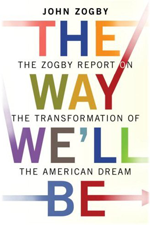Lowered Expectations and the "First Global" Generation

The Way We’ll Be: The Zogby Report on the Transformation of the American Dream.
By John Zogby; Random House (New York), 2008, 256 pages
John Zogby, author of The Way We’ll Be, is best known as a political pollster, and his tracking of voters’ opinions during presidential elections always receives widespread attention. But Zogby also investigates and interprets public opinion for a remarkable range of corporations and professional organizations. To develop the ideas in this book, he draws on both his consumer research and his political work, revealing fascinating nuances in the attitudes of US citizens toward the American Dream today and sketching a picture of what’s to come.
Written before the November 2008 presidential election, but after the economy had started collapsing, The Way We’ll Be predicted the national Democratic victory: “Americans have tired of the lone-wolf superpower mind-set that still holds such sway on Pennsylvania Avenue.” Zogby also foreshadowed the bankruptcies of GM and Chrysler “GM’s jingoistic ‘This Is My Country’ ad campaign for the Chevy Silverado is the wrong message in the wrong decade to a shrinking demographic.” Even without benefit of a crystal ball, it was clear to Zogby that whether the US economy ended up in a long-term recession or just a dip, average Americans had begun years earlier to adjust downward their expectations about what they could achieve in life.
Propelled by economic, technological, and sociological change, the American Dream is being redefined by all the generations of living adults, but most dramatically by today’s 18 – 29-year-olds, whom Zogby calls the “First Global” generation. Their attitudes are far different from those of 31 – 44-year-olds, 45 – 63-year-olds or 64 – 83-year-olds, whose attitudes are more closely grouped together. To be sure, “First Globals” still are narcissistic and materialistic, as are all young adults, however they are the most outward-looking and open-minded generation researchers have yet seen.
Each of the early chapters ends with short, insight-filled guides for marketers, helping them respond to the chapter topic. For instance, in the section “A Quick Guide to Marketing to ‘First Globals’” it states, “For them, just about everything is in the public domain, up to and including intimate details of their lives.” This fact should fill marketers with glee, since it makes “FGs” easy to reach through social networking tools.
Zogby’s interpretation of our new version of the American Dream is characterized by four meta-movements:
- Living within limits—moving from a nation of excess to one that accepts limits to consumption, curbed ambitions, and restraints on the unilateral use of military power
- Embracing diversity—not only of race and ethnicity, but of ideas and lifestyles
- Looking inward—seeking not just material goals but personal fulfillment
- Demanding authenticity—reconnecting with the truths of life and rejecting the illusions created by advertisers, institutions, and politicians.
Those who are looking inward for deeper meaning are identified as “Secular Spiritualists,” seeking nonmonetary goals among their highest aspirations. One way this trend is seen to be influencing consumer behavior is that total Christmas holiday spending has been in sharp decline ever since the mid-1990s. If that trend continues, both retailers and producers of holiday shows may have even more to worry about than recession-driven reductions in disposable income. Another example showing the importance of a new vision of spiritualism and authenticity is the rapidly growing house-church movement, where people gather in each others’ homes for religious services. Zogby asserts that this impulse will one day overshadow the impersonal and hierarchical megachurches that have proliferated in recent years.
The final chapter includes a psychographic profile of the four dominant age cohorts of our time. It foresees that the middle-aged “Woodstockers” (45–63 year olds) will team up with the “Private Generation” (64–83) to finally force Congress to pass health care reform, “although it might not be anything too radical.” “Woodstockers,” we baby boomers who have had such attention lavished on us our whole lives, will keep asking “What’s next for us?” Maybe learning to live within one’s limits will provide part of the answer. “Small is Beautiful” may be the theme for our much longed-for second act. Zogby also surmises that “‘Woodstockers’ will finally get tired of trying to look and act like their children.”
Members of the “Nike Generation” (31 – 44) are the consumer force propelling the popularity of independent films and music as well as alternatives in medicine and education models. Members of this cohort are the most likely to be “Secular Spiritualists.” They feel alienated from institutions but hungry for food for the soul.
For “First Globals,” all politics is global. Mainly because of their open-minded worldview, “The America of 2020 will be a more tolerant nation.” There is an immense gulf between them and the “Private Generation” for whom globalization is a threat to traditional nationalism and familiar traditions. Yet the “Privates” should not be dismissed altogether. Having greater vitality in old age than previous generations, they will constitute a new army of volunteerism benefiting nonprofits. They also will represent an as-yet-untapped consumer market for such services as lifelong learning and educational travel.
The Way We’ll Be gives the reader a fascinating summary of the way attitudes are changing about the federal government, race, workplace preferences, global warming, mass transit, and sexual orientation. It also tracks major distinctions in the prevalence of behaviors such as internet use and travel abroad—contrasting the habits of 18–29 year olds with those of the older age cohorts. In the current economic climate, one can’t help but wonder if the challenge that the illustrious “First Globals” are having finding gainful employment will dampen their surpassing humanitarianism. One hopes not because, as this book makes clear, this country needs all their collective compassion, and then some.
